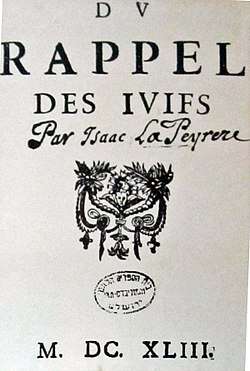Isaac La Peyrère
Isaac La Peyrère, also known as Isaac de La Peyrère or Pererius (1596–1676), was a Marrano[1] French Millenarian theologian and formulator of the Pre-Adamite hypothesis.
Life
La Peyrère was a lawyer by training and a Calvinist by upbringing, though he later converted to Catholicism.
La Peyrère served as secretary to the Prince of Condé on whose orders he lived for one month in 1654 in a house in the Southern Netherlands adjoining that of the recently abdicated Queen Christina of Sweden. Christina is said to have financed the anonymous publication of Prae-Adamitae.[2] During this time both Christina and La Peyrère met with Menasseh Ben Israel, who was later invited by Oliver Cromwell's government to England to negotiate the readmission of Jews to that country. Menasseh became a convert to La Peyrère's belief that the coming of the Jewish Messiah was imminent. La Peyrère also argued that Messiah would join with the king of France (that is, the Prince of Condé, not Louis XIV of France) to liberate the Holy Land, rebuild the Temple and set up a world government of the Messiah with the king of France acting as regent. It has since emerged that, in fact: "Condé, Cromwell and Christina were negotiating to create a theological-political world state, involving overthrowing the Catholic king of France, among other things".[3]
La Peyrère was influenced by Thomas Hobbes and was an influence on Baruch Spinoza.
Works

In his Prae-Adamitae, published in Latin in 1655 and in English as Men Before Adam in 1656, La Peyrère argued that Paul's words in Chapter 5, verses 12-14 of his Epistle to the Romans should be interpreted such that "if Adam sinned in a morally meaningful sense there must have been an Adamic law according to which he sinned. If law began with Adam, there must have been a lawless world before Adam, containing people".[4] Thus, according to La Peyrère there must have been two creations: first the creation of the Gentiles and then that of Adam, who was father of the Jews. The existence of pre-Adamites, La Peyrère argued, explained Cain's life after Abel's murder which, in the Genesis account, involved the taking of a wife and the building of a city. This account of human origins became the basis for 19th century theories of polygenism and modern racism. This polygenesis of the Gentiles was his method of explaining the existence of the Negroes, Chinese, Eskimos, American Indians, Malays and other people groups being discovered.[5]
La Peyrère's contentions were fiercely criticized by Protestant, Jewish and Catholic authorities. In 1656 after a storm of indignation the Prae-Adamitae was publicly burned in Paris and La Peyrère was imprisoned briefly during a visit to the Catholic Spanish Netherlands, but was released after he supposedly recanted.
In 19th-century Europe polygenism and Pre-Adamism were attractive to those intent on demonstrating the inferiority of non-Western peoples, while in the United States those attuned to racial theories who found it unattractive to contemplate a common history with non-Whites, such as Charles Caldwell, Josiah C. Nott and Samuel G. Morton, also rejected the view that non-whites were the descendants of Adam. Morton combined pre-Adamism with cranial measurements to construct a theory of racial difference that justified slavery. As Michael Barkun explains,
- In such an intellectual atmosphere, Pre-Adamism appeared in two different but not wholly incompatible forms. Religious writers continued to be attracted to the theory both because it appeared to solve certain exegetical problems (where did Cain's wife come from?) and exalted the spiritual status of Adam's descendants. Those of a scientific bent found it equally attractive but for different reasons, connected with a desire to formulate theories of racial difference that retained a place for Adam while accepting evidence that many cultures were far older than the few thousand years humanity had existed, according to biblical chronology. The two varieties differed primarily in the evidence they used, the one relying principally on scriptural texts and the latter what passed at the time for physical anthropology.[6]
References
- Almond, Philip C. (1999). Adam and Eve in Seventeenth-Century Thought. Cambridge: Cambridge University Press. ISBN 0-521-66076-9
- Barkun, Michael (1996). Religion and the Racist Right: The Origins of the Christian Identity Movement. UNC Press. ISBN 0-8078-4638-4
- Garber, Daniel and Ayers, Michael (Eds.). (2003) Cambridge History of Seventeenth-Century Philosophy. Cambridge: Cambridge University Press. ISBN 0-521-53720-7
- Popkin, R. H. (1987). Isaac La Peyrère (1596–1676): His Life, Work and Influence. Brill Academic Publishers. ISBN 90-04-08157-7
- Pyenson, Lewis (1989). Empire of Reason: Exact Sciences in Indonesia, 1840-1940. Brill Academic Publishers. ISBN 90-04-08984-5
Notes
- ↑ La Peyrère, Isaac; Jewish Virtual Library
- ↑ Pyenson, 1989, p. 149.
- ↑ Garber & Ayers, Cambridge History of Seventeenth-Century Philosophy, p. 407.
- ↑ Almond, 1999, p. 53.
- ↑ Pre-Adamic man: were there human beings on Earth before Adam?
- ↑ Barkun, 1996, p. 153.